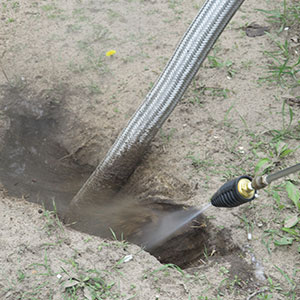 Soil can be excavated or moved in a variety of different ways. When pressurized water is used to remove the soil, the process is known as hydro excavation. The soil that has been removed is transferred to a special tank for storing debris through the use of a vacuum or air conveyance. This process offers numerous benefits over other excavation techniques. It is nondestructive and provides superior accuracy when locating utilities that are buried underground.
Soil can be excavated or moved in a variety of different ways. When pressurized water is used to remove the soil, the process is known as hydro excavation. The soil that has been removed is transferred to a special tank for storing debris through the use of a vacuum or air conveyance. This process offers numerous benefits over other excavation techniques. It is nondestructive and provides superior accuracy when locating utilities that are buried underground.
An Overview Of Hydro Excavation
Two main components are involved in the hydro excavation process: pressurized water and a special air vacuum. When the pressurized stream of water comes in contact with the soil, it causes it to break up. The resulting slurry is removed from the area that is being excavated using the air vacuum. Any debris is moved to a special holding tank.
Most hydro excavation projects rely on one of two different vacuum sources: a positive displacement blower or a fan system. Fan systems speed up the excavation process since they are capable of moving large volumes of air. Systems like these are generally simpler to use. For the most part, they also cost less and are lighter weight than positive displacement blowers.
The main advantage of a positive displacement blower is that it is capable of transporting air over greater distances when compared to a fan system. This allows them to handle deeper excavations, although the process is a lot slower. That is why fan systems are the preferred choice for most hydro excavation projects.
During hydro excavation, an air vacuum and pressurized water work in conjunction with one another. The water cuts and breaks up the soil, while the vacuum removes the resulting slurry from the area that is being excavated. The slurry is moved to a special tank for holding the debris.
Common Hydro Excavation Applications
Most construction projects include underground utilities or other buried components. Excavating soil so that utilities like these can be installed can be challenging and risky. Hydro excavation takes a lot of the risk out of the equation.
Today, it is used for a variety of applications. Some of these applications include daylighting and potholing. It is also used for installing poles, signs, and lines. The hydro excavation equipment can be located away from the area that is being excavated, which usually results in fewer problems with traffic or congestion.
Hydro excavation is also commonly used for rehabilitating sewer systems and pipes. The risk of puncturing or causing any further damage to the pipes is significantly reduced with this excavation method. This helps keep the cost down while allowing projects to be completed more quickly.
Hydro excavation is also used for landscaping projects. Thanks to its accuracy, nearby soil doesn’t have to be disturbed. This ensures that the ground around the excavated area remains compact and retains its strength.
Advantages Of Hydro Excavation
When it comes to industrial excavation, hydro excavation offers many advantages. Its accuracy and efficiency have made it one of today’s most popular excavating techniques.
One of the main advantages of hydro excavation is that it is safer and less likely to cause damage than other mechanical soil removal techniques. The accuracy of this type of excavation reduces on-the-job accidents while removing the soil in the most efficient way possible.
Hydro excavation also minimizes the risk of damage for cables, lines, and pipes that are buried underground. This helps keep project costs down by eliminating the need for expensive repairs. Without having to stop to do repairs, projects get completed more quickly, as well. Anytime utilities are interrupted, it is not only inconvenient but also quite costly. Hydro excavation helps reduce interruptions and keeps any damage to a minimum.
There are long-term advantages, as well. Since fewer repairs are required and safety is improved, this excavation method also lowers liability-related expenses. Insurance costs usually also decrease. Companies that use this excavation method are often more profitable and well-respected, as well.
From the perspective of the customer, hydro excavation provides a much better overall experience, which is why it is the preferred excavation method for so many of today’s projects.
